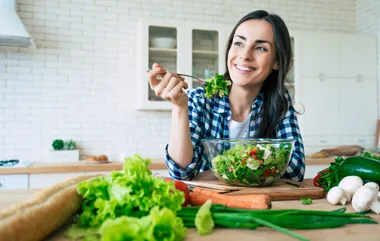‘I’m 2½ months pregnant and the baby has a slow heart. What should I start eating for the baby to be healthy and strong?’
— Emma
It’s so distressing to hear this kind of news at any stage during your pregnancy but there are many people who live to a grand old age with a slow heart rate. That said, you are quite right to do all you can, and your diet is certainly the place to start.
For cellular growth your baby needs protein. Good quality lean meat, poultry, eggs, fish and low fat dairy are all excellent sources of protein. Also essential for the growth and development of the brain, retina and heart is Omega 3 essential fatty acid. This fatty acid cannot be made in the body but is found in breast milk. Studies have shown the more Omega 3 in the diet, the more is found in the breast milk after birth, particularly with second, third or more children.
Many foods today, like eggs and milk are fortified with Omega 3, but it’s mainly found in oily fish, salmon being the highest source. Two to three 150g serves of fish each week is a great way to boost your overall health and your Omega 3 supplies.
Being pregnant, you should however avoid the species shark, swordfish, catfish, marlin, and ocean perch (or orange roughy as it’s otherwise known) as they have a higher content of mercury which can present a health risk to your baby.
The golden rule applies both in and out of pregnancy when it comes to vegetables — 5 serves, and in your case particularly green veggies such as spinach, broccoli, Chinese greens, asparagus and cabbage. They’re a good source of folic acid and provide numerous antioxidants to protect both you and your baby.
‘Is a lot of olive oil bad for you when you are using it for cooking?’ The old cliché ‘Everything in moderation’ applies to using olive oil even though it is a healthy oil.
High in monounsaturated fat, olive oil can help reduce LDL cholesterol (the bad stuff) and the risk of heart disease, but like any other fat, it’s high in energy. One tablespoon of olive oil is the equivalent to 673kj, so if you want to lose weight and are trying to stick to an energy controlled intake of approx 6,500KJ, you shouldn’t be pouring it liberally into the saucepan.
Another consideration when using olive oil in cooking is the type of oil you use. Many people are under the impression that cold pressed extra virgin olive oil is the healthiest oil to use. Cold pressed virgin oils are terrific for salads but have a lower smoke point than refined oils. When an oil is heated to the point of smoking it starts to decompose, effecting the taste of the food and increasing the risk of producing carcinogenic free radicals in the body.
So the bottom line is, olive oil is a healthy fat and should be included in moderation in the diet but don’t use cold pressed extra virgin oil in cooking.
‘I have recently found out I have an intolerance to citrus. What are the best substitutes for citrus fruits in cooking, and other sources of vitamin C?’
— Kirsty
Without knowing specifically what it is in citrus fruits you are intolerant to it’s hard to advise, however, assuming it’s not salicylates*, there are many other foods rich in vitamin C.
Vitamin C is a very unstable nutrient and is easily destroyed by cooking, so while most vegetables are a good source of this nutrient, unless you eat them raw their value is diminished somewhat. Kiwi fruit, berries and guava are particularly good sources as are raw veggies including watercress, red capsicum, broccoli, and tomatoes.
As a substitute to lemon in cooking you could use vinegar. Brown rice, white balsamic and red wine vinegars are quite good. Lemongrass can impart a slight citrusy flavour and olive and capers will give food zing.
Before following this advice you should seek the advice of a practising natural health practitioner to ascertain exactly what you are intolerant to.
*Salicylates are naturally occurring plant chemicals found in many fruits and vegetables and other natural foods
‘Gluten intolerance and diabetes combined — I have this double whammy and am in desperate need of help. Some tell me to get a diabetes recipe book, which is no good for me. Have you any combined recipes for my condition? I would be very grateful for your help. I’ve tried so many people and they can’t or won’t help me.
— Leonie
The difficulty with the double whammy of gluten intolerance and diabetes is the the radical change you must make to your diet. Virtually all cakes, pastries and bread must be eliminated, even the packaged products specifically for gluten intolerant as they are typically made with high GI grains, like rice and miller, and sugar.
The safest and often overlooked food group for someone with your condition is legumes and pulses. Buckwheat flour, quinoa and besan flour (or chickpea flour ) are also gluten free with a low GI.
The website www.thefoodcoach.com.au currently has over 600 recipes and each is labeled with a health description so people can quickly determine if it’s suitable to meet their needs.
Go to the recipe section and using the search criteria “health condition” select recipes for “gluten free”. There are 131 gluten free recipes. Scan through the list to select the ones you like the sound of before reading the recipe to check it’s GI status. If the recipe indicates it has a low GI then it’s suitable for both your conditions.










